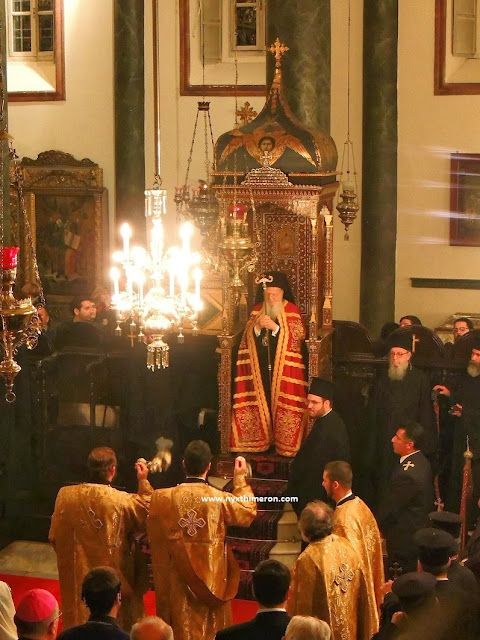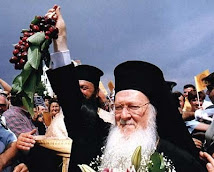The Primacy of Constantinople
by Archimandrite Panteleimon Manousakis, Assistant Professor, College of the Holy Cross, Boston
In the past we had the opportunity to discuss the need for primacy in the Church in general.[1] Our discussion demonstrated, to the best of our abilities, that such a primacy is required by the very structure of the Church’s ecclesiology and, furthermore, it is a prerequisite necessitated by the Church’s theology. It was that same theology that gave us the insight to primacy’s personal character insofar as it can be exercised only by a person. That person is, in principle, the bishop of Rome. Yet, the separation of the Catholic from the Orthodox Church meant, first and foremost, that the Orthodox Churches have been deprived from the benefits embodied in such a personal primacy. What would have been expected was that, in the absence of the Roman primacy, the ministry of that primacy ought to have been exercised by and recognized unanimously and unambiguously by the Orthodox themselves in the see next after the elder Rome in the taxis of the Pentarchy, namely the Patriarchate of Constantinople, the New Rome, and more specifically in the person of the Patriarch of Constantinople. In fact, the ancient appellation of Constantinople as New Rome would have assumed on this occasion a quasi-prophetic meaning, as it would have anticipated that this church was destined to become the Rome for the Eastern Churches in the event that the communion with the elder Rome were to be severed.
So much seems to be suggested by the spirit of the canons which afforded Constantinople with prerogatives and privileges comparable only to those of Rome (cf., the 3rd canon of the Second Ecumenical Council and the 28th canon of the Fourth Ecumenical Council). Thus, on the authority of these two Ecumenical Councils, the Church of Constantinople was granted a unique status among the remaining Eastern Patriarchates (Alexandria, Antioch, and Jerusalem), as, for the first time, a see is given jurisdictional rights beyond the borders of its immediate locality (ὑπερορίως, ultra montes).
The justification for this state of exemption[2] was provided by the primacy that Constantinople already had come to exercise as the Imperial City. The codification of that primacy by the canons was simply the de jure recognition of a ministry that Constantinople had assumed de facto.
This idea, however, is today contested and has become a point of contention among the Orthodox Churches so much so that it threatens to derail their dialogue with the Catholic Church.[3] It is, therefore, both expedient and appropriate for our discussion to raise the crucial question of primacy within the Orthodox world itself. For without such primacy there can be no hope for unity and without unity the dialogue with Rome is destined to remain fragmentary, episodic, and indecisive. It is in fact the question of primacy—or more accurately the lack thereof—the sole, singular impediment to the union of the Church, for as a theoretical issue (Petrine primacy) it divides Catholics from Orthodox while as a reality it divides the Orthodox among themselves. In the debate over primacy the Orthodox can feel the need to unite with Rome in its most palpable and tragic urgency—yet, without the recognition of some primacy within the Orthodox Church neither the Orthdox can reach out to Rome nor could Rome reach to the Orthodox Church. In one of those ironic turns of history, it is only Rome that can help the Orthodox communion overcome its own internal divisions. The possibility of a schism among the various Orthodox churches looms as real today as ever over any reconciliatory effort with the Catholic Church; furthermore, it taints and undermines Orthodoxy’s witness to the world and remains a danger of the Orthodox Church’s well-being like a ticking time bomb at its foundations.
Since the fall of the Byzantine Empire the vicissitudes of history changed in unexpected ways the geopolitical map of the Orthodox world. Russia’s assent to political power, first under the Czardom and more recently as a Soviet superpower, created the impression—and for some the pious expectation—that the new center of Orthodoxy could and ought to be moved to Moscow. Yet, the Patriarchate of Moscow was never trans- or inter-national. Rather, it was always bound to the history and the destiny of the Russian people. As such, therefore, it could not substitute the Ecumenical Patriarchate for it could never become truly ecumenical without ceasing being itself (the Church of Russia).
On the other hand, Constantinople as the Eastern Roman capital was, by its very foundation by Constantine the Great and as the capital of a truly international Empire, a cosmopolitan and universalist Church. Its language was Greek, the lingua franca of the whole Eastern Empire, but it was comprised by people of diverse nationalities, histories, and cultures. As such it was and still remains best suited to avert the dangers of nationalism to which, as the last two centuries have made painfully clear, Orthodoxy is particularly prone.
Constantinople was ecumenical, therefore, precisely because it was that particular city. In other words, it was universal because it was particular and it was particular because it was universal. Without its particularity, that is, without its embodiment in Constantinople, the Ecumenical throne would have been an abstraction and a utopia. Without its universality, the city would have remained parochial. In the Church of Constantinople a theological principle—that may look paradoxical in our secular eyes—is upheld: there is no true immanence (particularity) without transcendence, nor is there a genuine transcendence (universality) without immanence.
In consequence, the mission and ministry of the Church of Constantinople is precisely to preserve this paradox that recognizes in the particular the universal, in the single individual the pleroma of an incalculable plurality, in the one the dignity of the many, or indeed of all. It is on account of such theological sensitivity—as exemplified in the parable of the lost sheep, where the one is equal to the ninety-nine—that the Church of Constantinople has rejected those secular reasoning which calculate power and relevance by numbers. Often, if only implicitly, the remark has been made that other sister Churches, with more numerous flocks, should be given a primacy not in line with the Orthodox Church’s tradition and canonical organization (taxis). That would be a primacy of numbers. But is such a primacy acceptable by the Church? Primacy is a quality—how could it, then, be decided by quantifying criteria? Truth does not necessary lies in numbers, nor can be decided on statistical accounts. The logic of the primacy of numbers is condemned by the Gospel the Church preaches and to accept that logic would render it fundamentally inconsistent with its own kerygma.
Nevertheless, even if one were willing to discard these serious objections and, in addition, if one were to discount the flock of the Church of Constantinople in Australia, the Americas, Asia, and Western Europe, are we allowed to “disenfranchise” the dead? Are we allowed to count as nothing those same believers who inhabited for centuries the lands of the Ecumenical Throne and whom, even though they have fallen asleep, the Church continues to commemorate daily in our liturgies and prayers? Let others boast on the numbers of their living, the Church of Constantinople is proud of its dead: martyrs and saints, confessors and hierarchs, faithful of every walk of life—a cloud of living souls surrounds the walls of the Phanar (cf. Heb. 12:1).
On this score too, the Church of Constantinople stands with tradition and for tradition as it was once defined in the whimsical and inimitable way of G. K. Chesterton:
Tradition may be defined as an extension of the franchise. Tradition means giving votes to the most obscure of all classes, our ancestors. It is the democracy of the dead. Tradition refuses to submit to the small and arrogant oligarchy of those who merely happen to be walking about. All democrats object to men being disqualified by the accident of birth; tradition objects to their being disqualified by the accident of death. (...) We will have the dead at our councils. The ancient Greeks voted by stones; these shall vote by tombstones.[4]
_________________________________
[1] See our “Primacy and Ecclesiology: The State of the Question” in Orthodox Constructions of the West, edited by Aristotle Papanikolaou and George Demacopoulos (Fordham University Press, 2013), pp. 229-239, and “Τὸ Πρωτεύον Πρόβλημα τοῦ Πρώτου” in Νέα Εὐθύνη, vol. 15 (January-February 2013), pp. 65-67.
[2] Adam A. J. DeVille speaks of a Patriarchate that is “sui generis among the Eastern patriarchates” in Orthodoxy and the Roman Papacy, p. 82.
[3] “In October 2006 [sic], the commission [on the theological dialogue between the two Churches] resumed its discussions at Ravenna, though the event was marred by a ‘walkout’ on the part of the Moscow patriarchate’s representative. Bishop Hilarion’s protest was caused not for once by the wrongdoings, real or imagined, of the Catholic Church but by the presence of a delegation from the Estonian orthodox church, whose autocephaly, underwritten by Constantinople, is still denied in Russia. His action demonstrated, of course, the need precisely for a strong universal primacy so as to balance synodality in the Church.” So Aidan Nichols (in Rome and the Eastern Churches, p. 368). And he continues in assessing the unfortunate incident: “[t]he decision of the Moscow patriarchate in October 2007 to withdraw its representatives from the Ravenna meeting…was not only an irritating impediment to that dialogue; it was precisely the sort of happening that makes Catholics think the orthodox need the pope as much as the pope needs them” (ibid., p. 369).
[4] G.K. Chesterton, Orthodoxy in the Collected Works, volume I (San Francisco, Ignatius, 1986), p. 251.




















































































